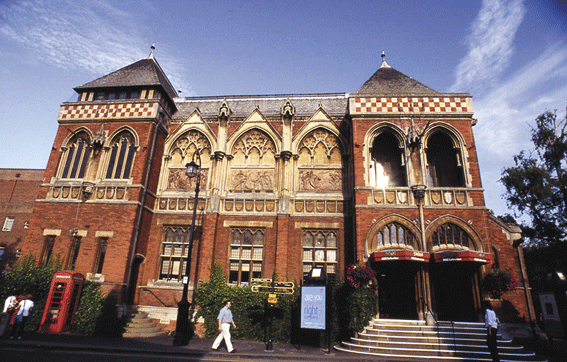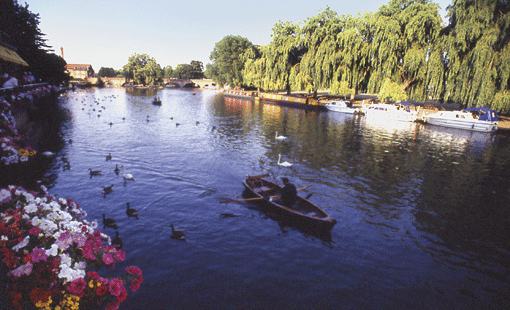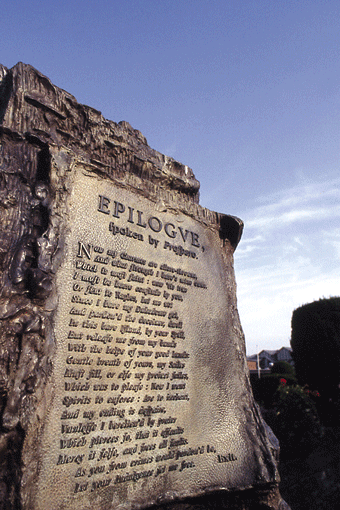
STRATFORD Shakespeare's Birthplace
Stratford -upon -Avon :
A Shakespearean Reverie
 |
| Swan Theatre Swan Theatre built in 1986 to a replica 'in-the-round' Jacobean stage is adjacent to the Royal Shakespeare Theatre. |
At Stratford-upon-Avon, you can sharpen your literary taste buds by visiting the home of William Shakespeare and much more.
By: Veronica Maria Garbutt
Lying on the banks of the River Avon in the heart of England’s Midlands, Stratford-upon-Avon is the United Kingdom’s most visited town after London. It was here in 1564 that William Shakespeare, probably the greatest writer to use the English language, was born. Later, having found fame in the capital, the town’s most illustrious son retired to his birthplace until his death in 1616.
Admirers of the Bard’s work have been coming to the town since then. A public appeal in 1847 to raise funds to buy the house in which he was born was successful. Since then Stratford has become a literary shrine to Britain’s greatest dramatist. It is also a thriving cultural centre as the provincial home of the Royal Shakespeare Company.
 |
| River Avon Boating on the River Avon is a popular summer pastime. |
Historically ‘street-ford’ was the place at which a Roman road linking Ryknild with Foss Way crossed the Avon. As a market town, it was prosperous long before Shakespeare’s birth. Many interesting buildings date from the 16th Century so it is fitting to start your visit from the medieval bridge which remains much as it was some 500 years ago. A sturdy low stone structure, it originally had 19 arches but two were demolished during the Civil War to improve the town’s defences.
Not far from the bridge’s town end lie Bancroft Gardens, home to the Gower Memorial which is dedicated to the Bard himself. It is surrounded by sculptures representing History, Philosophy, Comedy and Tragedy. Here colourful narrow-boats ply the canal basin and the river ferrying passengers from Bancroft Quay. The canal was opened in 1816, mainly for bringing coal to town. If you are feeling energetic, skiffs are available for hire.
From the foot of Clopton Bridge, stately Bridge Street leads up to High Street, a good place to shop or eat. Then it runs into Henley Street, home to Shakespeare’s Birthplace Museum, a half-timbered house that is surely top of everybody’s Bardic tour. The house is furnished in period fashion, in a style appropriate to the writer’s father John Shakespeare’s standing in the community.
The Glover part of the house which formed John’s workplace is now a museum. With the help of the Worshipful Company of Glovers it has been returned to the way it looked in the 16th Century. In the Birthplace itself, the rooms are furnished in similar period style and showcase displays of family history along with samples of William’s work.
Visitors enter through the Shakespeare Centre built in 1964 to commemorate the 400th anniversary of the Bard’s birth. It serves as the headquarters of the Birthplace Trust and houses extensive archives, a library and study facilities for students from all over the world. Across the street at the Shakespeare bookshop you can buy plays and poems as texts, videos and audio along with biographies, criticisms, study notes and books on Tudor history.
Another Birthplace Trust property, Nash’s House, lies not far away on Chapel Street. This half-timbered building belonged to Shakespeare’s granddaughter, Elizabeth Hall, and today is a museum of local history. Its stunning Elizabethan herb and knot garden is an added attraction. Next door is New Place where Shakespeare spent his retirement years from 1611 until his death there in 1616.
In the Old Town lies one of the best examples of a gabled house in Stratford, Hall’s Croft. It was named after Dr. John Hall who married the Bard’s daughter Susanna in 1607. Exhibits here illustrate medical practice during Shakespeare’s era. Outside, a walled garden features a large herb bed where Dr. Hall grew his remedies.
 |
| Epilogue Epilogue carved in stone at New Palace. |
The town is also home to three theatres, the most famous of which is the Royal Shakespeare Theatre which opened in 1879 with a performance of Much Ado About Nothing. Following a fire in 1926 a new theatre was designed by Elisabeth Whitworth Scott. Though solid and severe in style, the building fulfilled its brief in architectural terms and has magnificent Art Deco fittings.
Adjacent is the Swan Theatre built in 1986 to a replica ‘in-the-round’ Jacobean stage. During the day you can inspect the Royal Shakespeare Company Gallery—a treasure trove of costumes and theatrical paraphernalia or go on a backstage tour. The RSC also performs at a 150-seat theatre known as The Other Place in nearby Southern Lane, and in London.
For children the spectacular World of Shakespeare audio visual show is a must. Centred on the year 1576 when the Bard was 12, it depicts life in Tudor England using sound and lighting effects to dramatise the story. Also fun for the young ones is the Shakespeare Countryside Museum at Wilmcote northwest of Stratford where there are thrilling falconry displays along with tableaux illustrating the work of the blacksmith, wheelwright and other country craftsmen.
Adjacent lies the family home of Shakespeare’s mother, Mary Arden. It is a fine 16th Century building with a half-timbered frontage and striking gabled dormer windows. Clearly it shows the prosperity of Mary’s father, a gentleman farmer and, unusually for the time, she inherited the house and land. Continuous occupation has left the house almost perfectly preserved and it is now furnished in period style.
About one mile from Stratford lies Shottery, site of Anne Hathaway’s cottage where Shakespeare’s wife lived before marriage. More of a 12-room farmhouse with a garden and orchard, the building dates back to the 15th Century. Originally it was the home of prosperous yeoman farmer Richard Hathaway. His descendants lived here until the early 20th Century. The Shakespeare Tree Garden is laid out with most of the trees mentioned in the plays.
Dining out in Stratford is a pleasure and you will find many cuisines to choose from. The Opposition on Sheep Street is a good choice for a pre-theatre supper while Mallory Court, an early 20th Century neo-Tudor country house hotel with a panelled restaurant offers fine French dishes. The Stuart Restaurant of Billesley Manor is the place to go for roast beef and, unusually, Japanese food. And if it is Indian you are after, be sure to try Raj Tandoori Balti where you can eat for under 10 pounds sterling a head.
If you have time to spare to venture beyond the town don’t miss the Shire Horse Centre, home to many rare breeds, and Warwick Castle where you can frighten yourself in the Armoury and Dungeon. Last but not least is Charlecote Park where Shakespeare reputedly poached the deer that caused his hasty departure to London. The house and sweeping gardens (designed by Capability Brown) are the venue of especially staged activities each year.